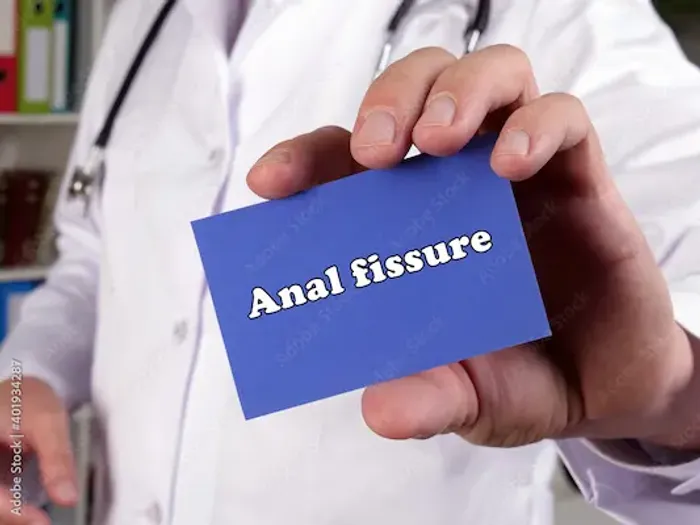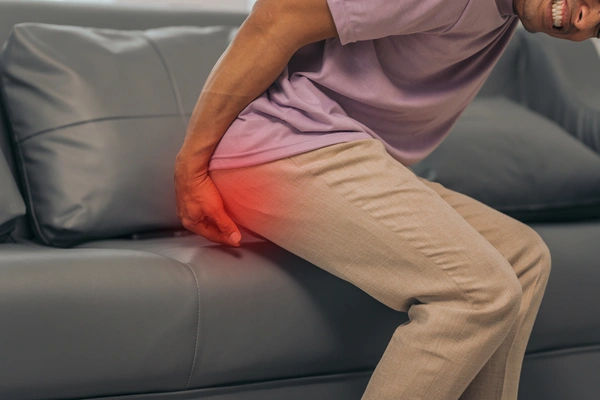What Leads To Signs Of Anal Fissure
A complete guide to anal fissures — what causes them, how to recognise symptoms, and the most effective home and medical treatments. Includes prevention tips, comparisons with haemorrhoids, and expert-backed advice for faster healing.

Written by Dr. Mohammed Kamran
Reviewed by Dr. Rohinipriyanka Pondugula MBBS
Last updated on 28th Oct, 2025

Introduction
Anal fissure pain can feel like “passing glass,” and the bright red blood on toilet paper can be alarming. The good news: most anal fissures heal with simple measures once you understand what causes them and how to treat them early. This guide explains what an anal fissure is, common causes, and key symptoms to watch for. It also compares fissures with haemorrhoids, outlines effective treatments, and shares prevention strategies. If symptoms persist beyond two weeks, consult a doctor online with Apollo 24|7 for further evaluation.
Quick Overview: What Exactly Is an Anal Fissure?
Understanding the condition helps you take the right steps early for faster relief.
Definition and Common Locations
An anal fissure is a small tear in the thin skin (anoderm) lining the anal canal. It’s a common cause of rectal pain and
bleeding, often triggered by passing hard stools or frequent diarrhoea. Most occur at the back (posterior midline) of the
anus; anterior fissures are more common in women after childbirth.
Acute vs Chronic Fissure
- Acute fissure: A new tear lasting less than six weeks, often healing with simple care.
- Chronic fissure: Lasts beyond six weeks, may feature a sentinel skin tag or exposed muscle, requiring prescription creams or minor procedures.
Consult a Top General Practitioner for Personalised Advice
Why It Hurts So Much: The Spasm–Blood Flow Cycle
Pain triggers anal sphincter spasm, reducing blood flow and slowing healing. This creates a painful cycle of spasm and
poor repair. Treatment focuses on softening stools, relaxing the muscle, and soothing the area.
What Leads to Signs of Anal Fissure? Root Causes and Triggers
Recognising triggers helps you prevent recurrence and protect delicate anal tissue.
Bowel Habits: Constipation and Diarrhoea
Hard stools and straining are the most common causes, while repeated diarrhoea can irritate and damage the lining.
Balanced fibre intake prevents both extremes.
Mechanical Trauma: Childbirth, Anal Intercourse, Enemas
Childbirth stretches the anal canal, increasing the risk of anterior fissures. Anal intercourse or improper use of enemas
can also cause small tears—gentle technique and lubrication reduce this risk.
Underlying Conditions: IBD, STIs, and Others
Inflammatory bowel disease, sexually transmitted infections, or rare conditions like anal cancer may mimic or cause persistent fissures. Non-healing or multiple tears should be checked by a doctor.
Diet and Lifestyle Factors
Low fibre diets, dehydration, sedentary lifestyles, and constipating medicines (such as opioids or iron) all increase risk.
Early Signs and Symptoms You Should Not Ignore
Identifying early signs ensures faster treatment and prevents chronic fissures.
Painful Bowel Movements and Tearing Sensation
Sharp pain during or after defecation is the hallmark symptom. Pain may linger for minutes or hours.
Bright Red Bleeding on Toilet Paper
Bleeding is usually small and bright red, seen on the paper or stool surface.
Sphincter Spasm, Lingering Pain, and Itching
Persistent throbbing or itching may occur due to muscle spasm or moisture.
Visible Tear or Sentinel Skin Tag
A small visible tear or flap of skin may be seen. Seek medical advice if pain or bleeding persists beyond two weeks.
Anal Fissure vs Haemorrhoids and Other Causes of Rectal Pain
Knowing the difference helps you choose the right treatment path.
Key Differences
- Anal fissure: Sharp pain with bowel movements, small bright red bleeding, usually a single tear.
- Haemorrhoids: Painless bleeding, itching, or lumps around the anus.
- Anal abscess/fistula: Constant pain, swelling, and possible discharge.
Red Flags for Other Diagnoses
Lateral or multiple fissures, severe bleeding, or systemic symptoms like weight loss require urgent medical review.
How Doctors Diagnose an Anal Fissure
Proper diagnosis rules out other conditions and ensures safe, targeted treatment.
History and Gentle Examination
Doctors assess your pain pattern, bowel habits, diet, and medication use. Visual inspection often confirms the diagnosis without the need for invasive testing.
When Scopes or Tests Are Needed
If the fissure is atypical, a short scope (anoscopy or sigmoidoscopy) or blood tests may be done to exclude other
conditions like IBD or infection.
Evidence-Based Home Care and First-Line Treatments
Most fissures heal with simple, consistent home treatments.
Fibre, Fluids, and Stool Softeners
Aim for 25–35 g of fibre daily with plenty of fluids. Psyllium husk or osmotic softeners can help if constipation persists.
Sitz Baths and Topical Anaesthetics
Warm sitz baths (10–15 minutes, two to three times daily) relax the sphincter and relieve pain. A short course of topical
lidocaine before bowel movements can help comfort.
Topical Vasodilators
Nitroglycerin or diltiazem/nifedipine creams increase blood flow and relax the muscle, promoting healing. Use a small
pea-sized amount twice daily for 6–8 weeks.
When to Seek Further Help
If bleeding or pain continues after two weeks, consult a doctor online with Apollo24|7 for tailored medical advice.
Procedures and Surgery When Symptoms Persist
Chronic fissures may need medical or surgical relaxation of the sphincter.
Botulinum Toxin Injection
Botox temporarily relaxes the muscle, helping healing in most chronic cases.
Lateral Internal Sphincterotomy (LIS)
A minor surgical procedure that permanently relieves spasm and heals over 90% of chronic fissures.
Fissurectomy or Advancement Flap
Used for complex or recurrent fissures when standard surgery carries risk of incontinence.
Special Situations: Pregnancy, Children, and Older Adults
Fissure management varies slightly by age and health condition.
Pregnancy and Postpartum Care
Constipation during pregnancy and after childbirth can cause fissures. Focus on fibre, fluids, and sitz baths; check
medication safety with your doctor.
Pediatric Fissures
Common in toddlers with constipation. Use stool softeners, fluids, and gentle hygiene.
Older Adults
Older adults may need milder treatments and closer continence monitoring after procedures.
Prevention and Daily Habits to Protect Anal Health
Simple daily habits can dramatically reduce recurrence risk.
The “Five-Minute Rule” and Toilet Posture
Avoid sitting on the toilet for more than five minutes and use a small footstool to improve bowel mechanics.
Diet Plan: High-Fibre Foods and Hydration
Include whole grains, fruits, and vegetables. Drink 6–8 glasses of water daily.
Exercise and Pelvic Floor Relaxation
Light exercise aids bowel movement and reduces stress. Applying a little petroleum jelly before defecation can reduce
friction during acute flares.
What the Top Resources Say: A Quick Synthesis
Medical consensus highlights the importance of early stool management and topical therapy.
Leading sources agree that constipation and diarrhoea are the main triggers, while first-line treatment involves fibre,
fluids, and topical calcium-channel blockers or nitroglycerin. Persistent fissures may need Botox or LIS. Telehealth can
support early management through Apollo24|7.
Myths and Mistakes to Avoid
Avoiding common errors helps you heal faster and prevent recurrence.
Overusing Laxatives
Relying on stimulant laxatives can worsen irritation—focus on dietary fibre and gentle softeners.
Ignoring Red Flags
Don’t delay seeking help if symptoms last more than six weeks or if bleeding is heavy.
Harsh Wiping and Irritants
Use soft, unscented tissue or water cleansing instead of harsh soaps or wipes.
When to Seek Urgent Care
Recognising danger signs ensures timely medical attention.
- Severe bleeding, fever, or chills
- Persistent pain beyond two weeks despite treatment
- Immunocompromised conditions increasing infection risk
If your condition does not improve, book a physical consultation with Apollo24|7.
Cost, Access, and What to Ask Your Doctor
Being prepared helps you make the most of your consultation.
Before Your Visit
Track symptoms, stool form, and diet changes. Bring your medication list.
Medication Costs and Side Effects
Nitroglycerin may cause headaches; diltiazem is often better tolerated. Ask about pricing and availability.
Telehealth and Follow-Up
Apollo24|7 provides online consultations, medication review, and follow-up scheduling for fissure management.
Conclusion
Anal fissures are painful but highly treatable. Most result from constipation, straining, or diarrhoea, leading to a cycle of muscle spasm and poor healing. Early care—soft stools, warm sitz baths, and topical creams—can stop this cycle. Seek medical help if symptoms persist or the fissure appears atypical. With smart toilet habits, hydration, and a fibre-rich diet, recurrence can often be prevented. Consult a doctor online with Apollo24|7 for personalised advice and treatment options.
Consult a Top General Practitioner for Personalised Advice
Consult a Top General Practitioner for Personalised Advice

Dr. Moumita Roy
General Physician/ Internal Medicine Specialist
8 Years • MBBS , MD (Anesthesiology)
Kolkata
VDC Clinic, Kolkata

Dr. Tapabrata Ray
General Physician/ Internal Medicine Specialist
4 Years • MBBS,DGM,CPMeC,ACMDC
Kolkata
MCR SUPER SPECIALITY POLY CLINIC & PATHOLOGY, Kolkata

Dr. S A Mallick
General Physician/ Internal Medicine Specialist
25 Years • MBBS , MD
Kolkata
Dr. S A Mallick's Chamber, Kolkata
(25+ Patients)

Dr. Rupam Chowdhury
Orthopaedician
10 Years • MBBS, DNB (Ortho.)
Kolkata
MCR SUPER SPECIALITY POLY CLINIC & PATHOLOGY, Kolkata

Dr. Arif Ahmed
General Physician/ Internal Medicine Specialist
9 Years • MBBS, MD (Genl. Med.)
Kolkata
MCR SUPER SPECIALITY POLY CLINIC & PATHOLOGY, Kolkata
Consult a Top General Practitioner for Personalised Advice

Dr. Moumita Roy
General Physician/ Internal Medicine Specialist
8 Years • MBBS , MD (Anesthesiology)
Kolkata
VDC Clinic, Kolkata

Dr. Tapabrata Ray
General Physician/ Internal Medicine Specialist
4 Years • MBBS,DGM,CPMeC,ACMDC
Kolkata
MCR SUPER SPECIALITY POLY CLINIC & PATHOLOGY, Kolkata

Dr. S A Mallick
General Physician/ Internal Medicine Specialist
25 Years • MBBS , MD
Kolkata
Dr. S A Mallick's Chamber, Kolkata
(25+ Patients)

Dr. Rupam Chowdhury
Orthopaedician
10 Years • MBBS, DNB (Ortho.)
Kolkata
MCR SUPER SPECIALITY POLY CLINIC & PATHOLOGY, Kolkata

Dr. Arif Ahmed
General Physician/ Internal Medicine Specialist
9 Years • MBBS, MD (Genl. Med.)
Kolkata
MCR SUPER SPECIALITY POLY CLINIC & PATHOLOGY, Kolkata
More articles from Anal fissure
Frequently Asked Questions
Q1. How can I tell if it’s an anal fissure or haemorrhoids?
Fissures cause sharp pain and bright red bleeding during bowel movements; haemorrhoids are usually painless or cause pressure and itching.
Q2. What’s the best home remedy for an anal fissure?
Soft stools, sitz baths, gentle hygiene, and, if needed, topical creams such as diltiazem or nitroglycerin.
Q3. How long does an anal fissure take to heal?
Most heal within 2–4 weeks with home care. Chronic fissures may need 6–8 weeks or medical procedures.
Q4. Is surgery always necessary for chronic fissures?
No. Many heal with topical therapy or Botox. Surgery is for persistent cases.
Q5. How can I prevent fissures from returning?
Maintain a fibre-rich diet, drink enough water, avoid straining, limit toilet time, and practise good hygiene.

